Imagine a city where traffic flows seamlessly, where red lights don’t make you wait unnecessarily, and where your commute time is cut by 40%. This isn’t science fiction—it’s the reality that AI in Smart Traffic Systems is creating today. As urban populations swell and roadways reach capacity, artificial intelligence is emerging as the critical technology that’s transforming how we manage traffic congestion, reduce emissions, and improve the quality of urban life.
From Singapore to Barcelona, cities worldwide are implementing intelligent traffic management systems that learn, adapt, and optimize in real-time. These systems don’t just react to traffic conditions—they predict them, preventing congestion before it happens. With the global smart transportation market projected to reach $277 billion by 2025, we’re witnessing the dawn of a new era in urban mobility.
This article explores how AI is revolutionizing traffic management, examines current applications and future trends, and highlights the transformative impact these technologies are having on our cities and daily commutes.
Understanding AI in Smart Traffic Systems
AI-powered traffic management systems integrate multiple data sources to optimize urban mobility
At its core, AI in Smart Traffic Systems represents the integration of artificial intelligence technologies with traditional traffic infrastructure to create responsive, adaptive transportation networks. These systems leverage a combination of sensors, cameras, and connected devices to collect real-time data about traffic conditions, which is then processed by sophisticated algorithms to make intelligent decisions.
The foundation of these systems rests on several key AI technologies:
- Machine Learning: Algorithms that analyze historical traffic patterns to identify trends and make predictions about future conditions.
- Computer Vision: Technology that enables cameras to recognize vehicles, pedestrians, and road conditions automatically.
- Deep Learning: Advanced neural networks that can process complex traffic scenarios and improve decision-making over time.
- Predictive Analytics: Tools that forecast traffic congestion before it occurs, allowing for proactive management.
Unlike traditional traffic management approaches that rely on fixed timing and manual adjustments, AI-powered systems continuously adapt to changing conditions. They can process vast amounts of data from multiple sources simultaneously, making them far more effective at managing the complex dynamics of urban traffic flow.
Current Applications of AI in Traffic Management
AI is already transforming traffic management across cities worldwide. Here are some of the most impactful applications currently in use:
Adaptive Traffic Signal Control

Adaptive traffic signal control represents one of the most visible applications of AI in Smart Traffic Systems. These intelligent systems adjust signal timing in real-time based on actual traffic conditions rather than following pre-programmed schedules.
In Pittsburgh, an AI-driven traffic signal system developed at Carnegie Mellon University has reduced travel times by 40% and decreased vehicle emissions by 21%. The system uses cameras and radar sensors to detect traffic volume and adjusts signal timing dynamically, reducing wait times at intersections and improving overall traffic flow.
Similarly, London’s SCOOT (Split Cycle Offset Optimization Technique) system uses AI to manage over 3,000 traffic signals, reducing delays by up to 12% across the network.
Predictive Traffic Flow Analysis
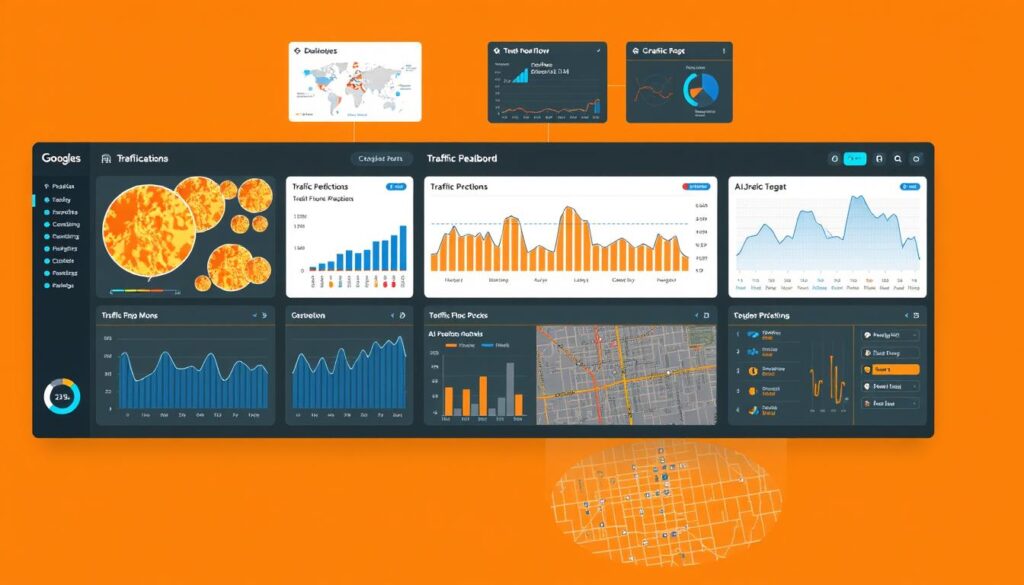
AI algorithms are increasingly being used to predict traffic patterns before congestion occurs. These systems analyze historical data, current conditions, and external factors like weather and events to forecast traffic flow with remarkable accuracy.
Google Maps uses AI to analyze vast amounts of real-time data from GPS signals, road sensors, and user reports to predict traffic conditions and suggest optimal routes. This technology has saved drivers countless hours by helping them avoid congested areas before they become trapped in traffic.
In Singapore, the Transport Authority employs predictive analytics to forecast traffic up to an hour in advance with 85% accuracy. This allows traffic managers to implement preventive measures before congestion occurs, such as adjusting signal timing or deploying traffic officers to critical areas.
Intelligent Parking Management
Finding parking in busy urban areas is a significant contributor to traffic congestion, with studies showing that up to 30% of city traffic is caused by drivers searching for parking spaces. AI-powered parking management systems are addressing this challenge by guiding drivers directly to available spots.
San Francisco’s SFpark program uses sensors to monitor real-time parking availability and directs drivers to open spaces via a mobile app. This has reduced the time spent searching for parking by 43% and decreased greenhouse gas emissions from circling vehicles.
Similar systems in Barcelona use AI to analyze parking patterns and predict availability, helping drivers find spaces more efficiently and reducing traffic congestion in the city center.
Ready to optimize your city’s traffic flow?
Discover how AI-powered traffic management can reduce congestion, lower emissions, and improve urban mobility in your community.
Connected Vehicle Integration

Vehicle-to-everything (V2X) communication is emerging as a powerful application of AI in Smart Traffic Systems. This technology enables vehicles to communicate with each other and with infrastructure elements like traffic lights and road sensors.
In Michigan, the Department of Transportation has implemented a connected vehicle corridor where traffic signals communicate with equipped vehicles to provide real-time information about signal timing and potential hazards. This system has improved traffic flow and reduced the risk of accidents at intersections.
As autonomous vehicles become more common, these connected systems will play a crucial role in coordinating traffic movement, potentially eliminating the need for traditional traffic signals altogether in some scenarios.
Benefits of AI in Smart Traffic Systems
Reduced Congestion and Travel Times
AI-powered traffic management systems have demonstrated significant reductions in congestion and travel times across multiple cities. By optimizing signal timing, predicting traffic patterns, and providing real-time routing suggestions, these systems keep traffic flowing more efficiently.
Studies have shown that adaptive traffic control systems can reduce travel times by 15-40%, depending on the specific implementation and local conditions. This translates to substantial time savings for commuters and improved productivity for the economy as a whole.
Lower Emissions and Environmental Impact
Traffic congestion is a major contributor to urban air pollution. When vehicles idle in traffic or repeatedly stop and start, they produce significantly more emissions than when traveling at consistent speeds.
By reducing congestion and optimizing traffic flow, AI in Smart Traffic Systems can substantially decrease vehicle emissions. Pittsburgh’s adaptive signal system has reduced emissions by 21%, while similar implementations in other cities have shown reductions of 10-30% in carbon dioxide and particulate matter.
Enhanced Safety for All Road Users
AI technologies are improving road safety through better traffic management and hazard detection. Computer vision systems can identify potential accident risks, such as pedestrians crossing against signals or vehicles making illegal maneuvers, and alert traffic managers or even communicate directly with connected vehicles.
In cities where AI-powered traffic management has been implemented, accident rates at managed intersections have decreased by up to 30%. These systems are particularly effective at reducing rear-end collisions, which often occur at poorly timed traffic signals.
Improved Urban Livability and Economic Benefits
Beyond the direct benefits to transportation, AI in Smart Traffic Systems contributes to more livable urban environments. Reduced congestion means less noise pollution, more reliable public transit, and more predictable travel times for both residents and businesses.
The economic benefits are substantial as well. Traffic congestion costs the U.S. economy an estimated $87 billion annually in lost productivity. By reducing congestion, AI-powered traffic management systems can recapture much of this lost value while improving quality of life for urban residents.
Case Studies: AI in Smart Traffic Systems Around the World
Singapore: A Pioneer in Smart Traffic Management
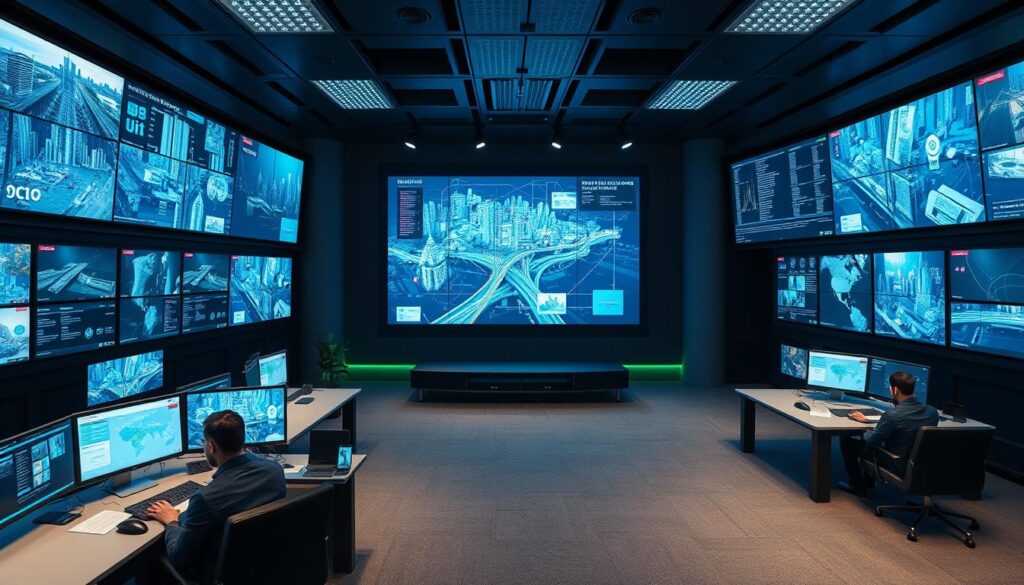
Singapore stands as a global leader in implementing AI in Smart Traffic Systems. The city-state’s comprehensive approach integrates multiple technologies to create one of the world’s most efficient urban transportation networks.
At the heart of Singapore’s system is the Intelligent Transport System (ITS), which uses AI to forecast traffic, support public transport scheduling, and manage road congestion in real-time. The system incorporates:
- The Green Link Determining (GLIDE) system, which optimizes traffic signal timing across 2,000+ intersections
- Expressway Monitoring and Advisory System (EMAS) that detects incidents and manages traffic on highways
- Predictive analytics that forecast congestion up to an hour in advance
- Electronic Road Pricing (ERP) that uses AI to implement dynamic congestion charging
The results have been impressive: average vehicle speeds on major arterials have increased by 20%, while travel time reliability has improved by 30%. Singapore’s system is particularly noteworthy for its integration of multiple transportation modes, including private vehicles, public transit, and pedestrian movement.
Barcelona: Smart Intersections and Urban Mobility
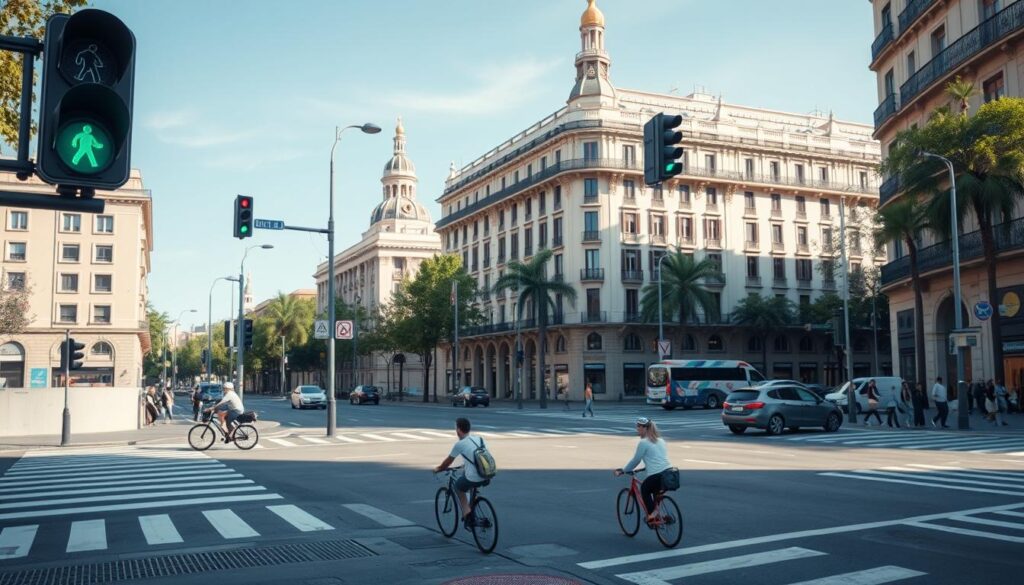
Barcelona has emerged as a European leader in smart city initiatives, with traffic management being a key focus area. The city’s approach emphasizes not just vehicle movement but comprehensive urban mobility that includes pedestrians, cyclists, and public transit.
Barcelona’s smart traffic management system includes:
- AI-powered traffic lights at 2,000+ intersections that adapt to real-time conditions
- Smart parking systems that have reduced searching time by 50%
- Integrated mobility platform that combines data from multiple transportation modes
- Superblocks initiative that uses AI to redesign traffic flow in residential areas
One of Barcelona’s most innovative applications is its use of computer vision to detect pedestrians at intersections and automatically extend crossing times for elderly or mobility-impaired individuals. This human-centered approach has improved safety while maintaining efficient traffic flow.
The city has reported a 21% reduction in congestion and a 17% decrease in emissions since implementing these systems, while pedestrian safety has improved significantly at AI-managed intersections.
Los Angeles: ATSAC and Real-time Traffic Management

Los Angeles, notorious for its traffic congestion, has implemented one of North America’s most advanced traffic management systems. The Automated Traffic Surveillance and Control (ATSAC) system manages over 4,500 traffic signals across the city using AI and real-time data analysis.
Key components of the LA system include:
- Adaptive traffic signal control that responds to changing traffic patterns
- Transit signal priority for buses and light rail vehicles
- Integration with the Regional Integration of Intelligent Transportation Systems (RIITS)
- AI-powered incident detection that identifies accidents and congestion
The system has reduced travel times by an average of 16% across the city, with some corridors seeing improvements of up to 25%. Additionally, fuel consumption has decreased by approximately 14%, resulting in significant environmental benefits.
Los Angeles is now expanding its system to incorporate more advanced AI capabilities, including predictive analytics and integration with connected vehicle technologies.
Transform your city’s traffic management
Learn how AI-powered traffic systems can be customized for your city’s unique transportation challenges.
Future Trends in AI-Powered Traffic Management
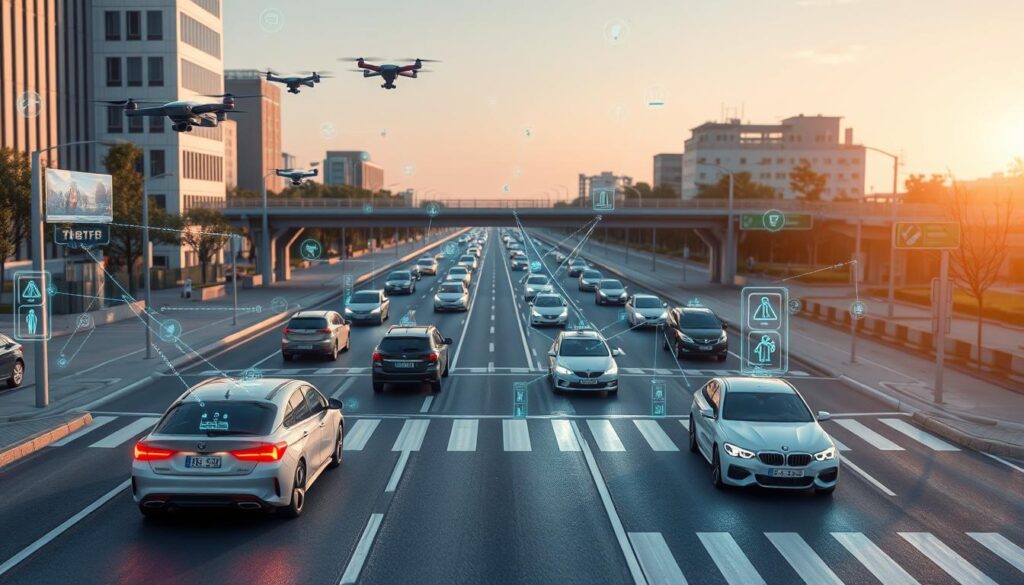
As AI technologies continue to evolve, the future of smart traffic systems promises even greater capabilities and integration. Here are some emerging trends that will shape the next generation of AI in Smart Traffic Systems:
Edge Computing for Real-time Processing
Edge computing—processing data closer to where it’s generated rather than in centralized cloud servers—is enabling faster, more responsive traffic management systems. By processing data from cameras and sensors directly at intersections, AI systems can make split-second decisions without the latency of cloud communication.
This technology will allow traffic signals to respond almost instantaneously to changing conditions, further improving traffic flow and safety. Cities like San Diego are already implementing edge computing in their traffic management systems, with response times reduced from seconds to milliseconds.
Digital Twins for Traffic Simulation
Digital twin technology—creating virtual replicas of physical systems—is emerging as a powerful tool for traffic management. By creating detailed digital models of urban transportation networks, traffic managers can simulate different scenarios and test management strategies before implementing them in the real world.
These simulations can incorporate AI to predict outcomes with remarkable accuracy, allowing cities to optimize traffic management strategies continuously. Singapore is pioneering this approach with its Virtual Singapore platform, which includes a comprehensive digital twin of the city’s transportation system.
Autonomous Vehicle Coordination
As autonomous vehicles become more common, AI will play a crucial role in coordinating their movement through urban areas. Rather than each vehicle making independent decisions, AI-powered traffic management systems will communicate directly with autonomous vehicles to optimize overall traffic flow.
This could eventually lead to “platooning,” where groups of autonomous vehicles travel closely together at consistent speeds, dramatically increasing road capacity. Early trials in cities like Phoenix, where Waymo’s self-driving taxis complete over 100,000 rides per week, are already demonstrating the potential of this approach.
Multimodal Transportation Optimization
Future AI traffic systems will increasingly focus on optimizing all forms of urban mobility, not just private vehicles. These systems will coordinate between different transportation modes—cars, buses, trains, bicycles, and pedestrians—to create more efficient and sustainable urban movement.
AI will help cities implement “mobility as a service” (MaaS) platforms that provide integrated transportation options based on real-time conditions and individual preferences. Helsinki’s Whim app, which uses AI to offer personalized multimodal transportation recommendations, offers a glimpse of this future.
Challenges and Considerations for Implementation
Benefits
- Reduced congestion and travel times (15-40%)
- Lower emissions and environmental impact (10-30%)
- Enhanced safety for all road users
- Improved urban livability
- Significant economic benefits
- More efficient public transportation
- Better emergency vehicle response
Challenges
- High initial infrastructure costs
- Data privacy and security concerns
- Integration with legacy systems
- Equity and accessibility issues
- Technical complexity and maintenance
- Regulatory and policy hurdles
- Public acceptance and adoption
While the potential benefits of AI in Smart Traffic Systems are substantial, implementing these technologies presents several significant challenges:
Infrastructure and Cost Considerations
Implementing AI-powered traffic management systems requires substantial investment in physical infrastructure, including sensors, cameras, communication networks, and computing resources. For many cities, especially those with aging infrastructure or budget constraints, these costs can be prohibitive.
However, the return on investment can be substantial. Studies have shown that every dollar invested in intelligent transportation systems can yield $10-$40 in economic benefits through reduced congestion, lower emissions, and fewer accidents. Cities can also implement these systems incrementally, starting with high-priority corridors and expanding over time.
Data Privacy and Security
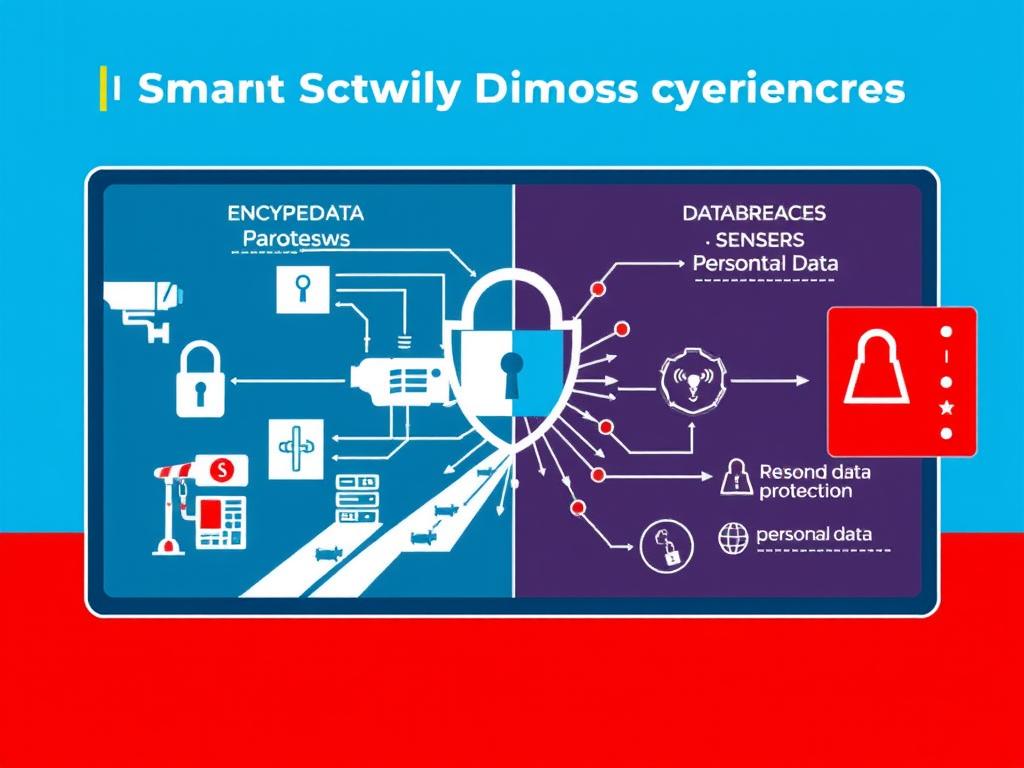
AI traffic systems collect vast amounts of data from various sources, raising important questions about privacy and security. While most systems anonymize data, there are still concerns about tracking and surveillance, particularly with camera-based systems that might capture identifiable information.
Robust data governance frameworks are essential to address these concerns. Cities must implement strong encryption, access controls, and data minimization practices while being transparent about what data is collected and how it’s used. Barcelona’s ethical digital standards provide a model for responsible data management in smart city applications.
Equity and Accessibility
As cities implement AI-powered traffic systems, ensuring equitable benefits across all communities is crucial. There’s a risk that these technologies could primarily benefit wealthier areas or certain types of road users (e.g., private vehicle owners) while neglecting others.
Inclusive design approaches can help address these concerns. This includes considering the needs of all transportation modes, ensuring that algorithms don’t inadvertently prioritize certain neighborhoods, and making traffic information accessible to everyone, regardless of technological access or ability.
Technical Complexity and Integration
Integrating AI systems with existing traffic infrastructure presents significant technical challenges. Many cities have legacy traffic management systems that weren’t designed to work with modern AI technologies, creating compatibility issues.
Successful implementation requires a phased approach that gradually introduces AI capabilities while maintaining existing systems. Open standards and interoperable architectures are essential to ensure that different components can work together effectively, regardless of vendor or technology.
Implementation Guide: Getting Started with AI in Smart Traffic Systems
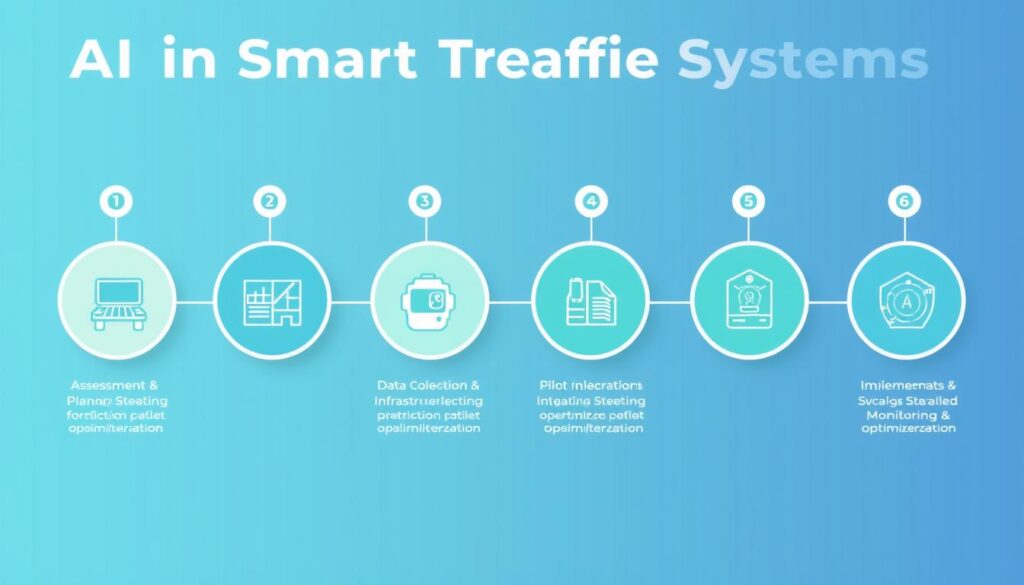
For cities considering implementing AI in Smart Traffic Systems, a structured approach can help navigate the complexities and maximize the benefits. Here’s a step-by-step guide to getting started:
1. Assessment and Planning
Begin with a comprehensive assessment of your current traffic management infrastructure and challenges. Identify specific problems that AI could help address, such as congestion hotspots, high-accident intersections, or inefficient signal timing. Engage stakeholders from transportation departments, community groups, and local businesses to understand diverse perspectives.
Develop clear objectives and key performance indicators (KPIs) to measure success. These might include reduced travel times, lower emissions, fewer accidents, or improved public transit reliability.
2. Data Collection Infrastructure
Implement the necessary infrastructure to collect high-quality traffic data. This typically includes:
- Traffic cameras at key intersections
- Inductive loop detectors or radar sensors to measure vehicle flow
- Weather sensors to account for environmental conditions
- Communication networks to transmit data in real-time
- Computing infrastructure to process and store data
Ensure that data collection systems are designed with privacy and security in mind from the outset, implementing encryption, anonymization, and access controls as appropriate.
3. Start Small with Pilot Projects
Rather than attempting a city-wide implementation immediately, begin with pilot projects in specific corridors or neighborhoods. This allows you to test technologies, refine approaches, and demonstrate value before scaling up.
Select pilot areas that represent different traffic conditions and community characteristics to ensure that solutions will work across diverse contexts. Document lessons learned and adjust your approach based on initial results.
4. Build Partnerships
Successful implementation often requires collaboration between multiple entities, including:
- Technology providers with expertise in AI and traffic management
- Academic institutions that can provide research support
- Other government agencies (e.g., environmental, emergency services)
- Community organizations that can provide feedback and support
Public-private partnerships can be particularly effective, combining government oversight with private sector innovation and investment.
Ready to implement AI in your traffic management strategy?
Our team of experts can help you assess your needs, develop a customized implementation plan, and measure the impact on your city’s transportation network.
5. Focus on Integration and Interoperability
Ensure that new AI systems can integrate with existing traffic management infrastructure and other smart city initiatives. Adopt open standards and APIs that allow different systems to communicate effectively.
Consider how traffic management connects with other urban systems, such as emergency services, public transit, and environmental monitoring. An integrated approach yields greater benefits than siloed implementations.
6. Monitor, Evaluate, and Iterate
Implement robust monitoring systems to track performance against your established KPIs. Collect both quantitative data (e.g., travel times, emissions) and qualitative feedback from system users and community members.
Use this information to continuously improve your implementation, adjusting algorithms, infrastructure, and approaches based on real-world results. AI systems improve over time with more data and refinement, so ongoing optimization is essential.
Conclusion: The Road Ahead for AI in Smart Traffic Systems
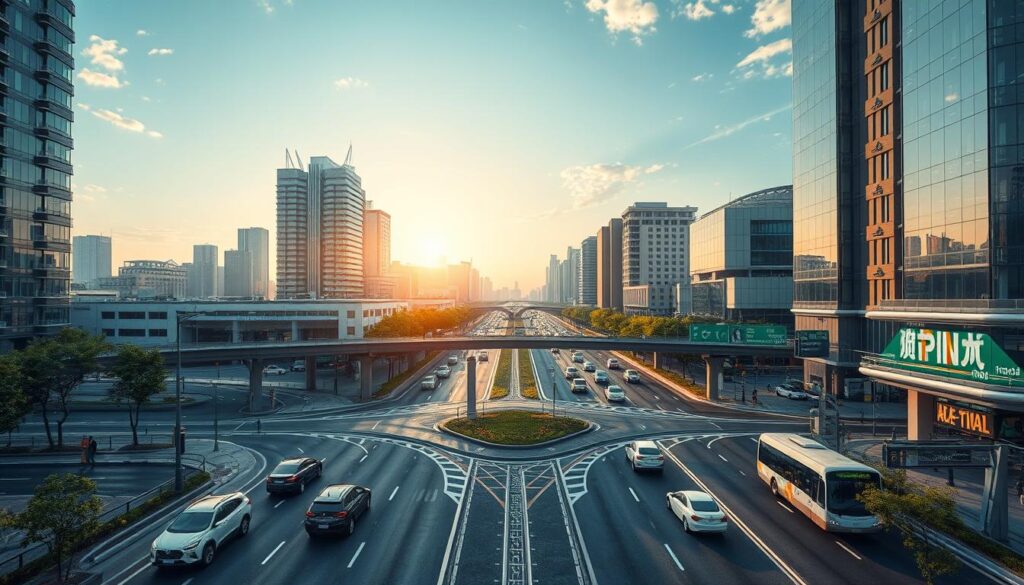
AI in Smart Traffic Systems represents one of the most promising applications of artificial intelligence in our daily lives. By transforming how we manage urban mobility, these technologies offer a path toward more efficient, sustainable, and livable cities.
The examples from Singapore, Barcelona, and Los Angeles demonstrate that these benefits are not theoretical—they’re being realized today in cities around the world. As AI technologies continue to advance and implementation costs decrease, we can expect to see more widespread adoption across cities of all sizes.
The future of urban mobility will likely be characterized by increasingly integrated and intelligent systems that optimize not just vehicle movement but the entire transportation ecosystem. From autonomous vehicles communicating with smart infrastructure to multimodal mobility platforms that seamlessly connect different transportation options, AI will be the connective tissue that makes these complex systems work together efficiently.
For urban planners, policymakers, and technology providers, the opportunity is clear: AI in Smart Traffic Systems offers a powerful tool to address some of our most pressing urban challenges. By embracing these technologies thoughtfully—with attention to equity, privacy, and sustainability—we can create transportation networks that serve all citizens while reducing environmental impact.
The road ahead for smart traffic systems is not without challenges, but the potential benefits make this a journey worth taking. As we continue to innovate and implement these technologies, we move closer to the vision of truly smart cities where mobility is efficient, sustainable, and accessible to all.
Start your smart traffic journey today
Join the growing community of cities leveraging AI to transform urban mobility. Our team can help you navigate the complexities and implement solutions that work for your unique context.







